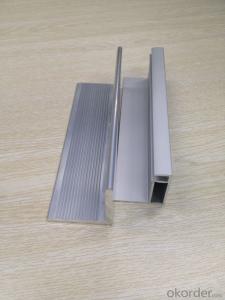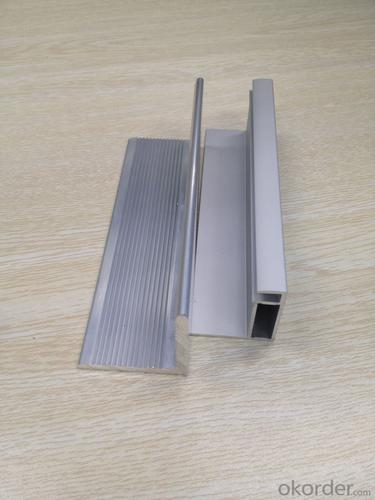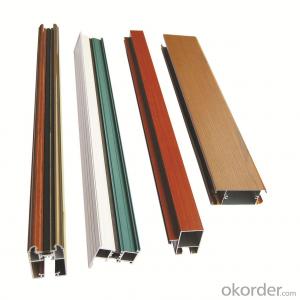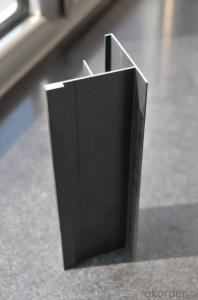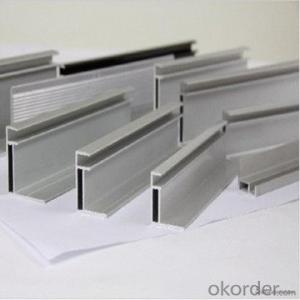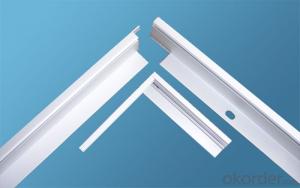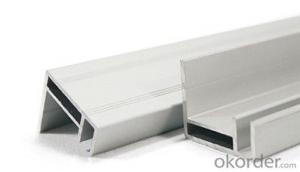Aluminum Angle Profiles for Solar Module Structure
OKorder Service Pledge
OKorder Financial Service
You Might Also Like
We are the largest aluminum profilemanufacture in
Provide full type of solar module frame:
Size:30x25mm
35x35mm
35x40mm
Other size can be accepted.
Material | Alloy Aluminum 6063,6061,6005,6082 or customer nominated |
Temper | T3, T4, T5, T6 and other |
Surface | Anodize, electrophoresis, powder coating, PVDF coating, wood grain painting, etc. |
Colour | Any colour based on Standard Germany RAL Mark |
Length | Not more than 16 meters |
Good Package | Inner plastic film /outside carton/wooden pallets |
Payment Method | T/T, L/C, etc |
Delivery Time | Normally 2-4 weeks, Delivery time can be consulted. |
Press Machine | 500-12500 tons all together 93 press lines. |
Fabrication | 1. Solar module frame; 2. Drilling; 3. Bending; 4. Cutting; 5. etc. |
Certificate | ISO/TS 16949,DNV,IRIS,CCS,AFA,etc. |
Dies | 1. Using our dies, no fee; |
2. Using customer drawing, opening dies, usually about 5~50 tons then the dies cost can be refunded. | |
3. Die cost is negotiable base on the order quantity | |
Capability | Annual output 800,000 tons |
- Q: The user is asking for methods to prevent aluminum profiles from warping or twisting while being installed.
- <p>To avoid warping or twisting of aluminum profiles during installation, ensure proper handling and support. Use sturdy brackets and supports to maintain alignment and prevent bending. Keep the profiles clean and free of debris that could cause uneven pressure. Avoid overtightening fasteners, which can cause stress and deformation. Use the correct tools and techniques for cutting and drilling to avoid damage. Maintain a consistent temperature and humidity during the installation process, as extreme conditions can affect the material's stability. Finally, inspect the profiles regularly for any signs of warping or twisting and address issues promptly.</p>
- Q: How do aluminum profiles perform in terms of weather resistance?
- Aluminum profiles exhibit remarkable weather resistance due to the unique qualities of aluminum itself, such as its resistance to corrosion and ability to endure harsh environmental conditions. To enhance their weather resistance, aluminum profiles are typically coated or anodized, providing long-lasting durability and protection against different weather elements. The corrosion resistance of aluminum is especially advantageous for outdoor applications. When exposed to oxygen, aluminum naturally forms an oxide layer, serving as a protective barrier against rust and deterioration. Consequently, aluminum profiles are highly resistant to moisture, rain, and humidity, making them suitable for use in coastal areas or regions with high levels of precipitation. Moreover, aluminum profiles also possess resistance against UV radiation. The application of surface treatments, such as powder coating or anodizing, adds an extra layer of defense against the sun's harsh rays. Consequently, aluminum profiles do not fade, chip, or crack when exposed to prolonged sunlight, ensuring their original appearance and structural integrity are preserved over time. Concerning extreme weather conditions, aluminum profiles are specifically designed to withstand high winds, extreme temperatures, and even severe storms. They possess excellent mechanical properties, including high strength and stiffness, enabling them to bear heavy loads and resist deformation. As a result, aluminum profiles are ideal for applications in construction, architecture, and outdoor infrastructure projects where weather resistance is of utmost importance. In conclusion, aluminum profiles exhibit exceptional weather resistance. Their inherent corrosion resistance, combined with the availability of various surface treatments, ensures their ability to endure a wide range of weather conditions while maintaining their structural integrity and aesthetic appeal.
- Q: This question asks for methods to ensure the reliable and durable installation of aluminum profiles.
- <p>To ensure the reliable and durable installation of aluminum profiles, follow these steps: Use high-quality aluminum materials that meet industry standards for strength and durability. Ensure proper alignment and level during installation to prevent warping or stress on the profiles. Use appropriate fasteners and adhesives recommended for aluminum to ensure a strong bond. Avoid over-tightening fasteners, which can cause deformation. Regularly inspect and maintain the profiles to check for signs of wear or damage, and address any issues promptly. This will help maintain the integrity and longevity of the aluminum profiles.</p>
- Q: Inquire about the various uses of aluminum profiles within the field of architecture.
- <p>Aluminum profiles have a wide range of applications in architecture due to their strength, durability, and lightweight properties. They are commonly used in curtain walls, which are the exterior coverings of buildings, providing both aesthetic appeal and structural integrity. Aluminum profiles are also utilized in window and door frames for their resistance to corrosion and ability to withstand various weather conditions. They are employed in structural glazing to hold glass in place securely. Furthermore, aluminum profiles are used in sun shading systems to control the amount of sunlight entering a building, enhancing energy efficiency. They are also found in handrails, balustrades, and other safety features for their strength and low maintenance requirements. Overall, aluminum profiles contribute to the sustainability and modern design of architectural projects.</p>
- Q: What are the safety regulations concerning the use of aluminum profiles in construction?
- <p>Yes, there are safety regulations related to the use of aluminum profiles in construction. These regulations vary by country and region but generally include requirements for material strength, durability, and resistance to environmental factors. Standards such as ASTM B221 for aluminum and aluminum alloy extruded bars, rods, and profiles, and ISO 6361 for aluminum and aluminum alloy extruded profiles, provide guidelines on dimensions, tolerances, and mechanical properties. Compliance with local building codes and regulations is crucial, which may include fire resistance, load-bearing capacity, and corrosion resistance. Additionally, proper installation practices and adherence to manufacturer's specifications are essential to ensure safety and structural integrity.</p>
- Q: What are the various materials incorporated in the production of aluminum profiles?
- <p>Aluminum profiles are primarily made from aluminum alloys, which can include different elements to enhance properties such as strength, corrosion resistance, and machinability. Commonly used alloys are 6063, 6061, and 6082. Other materials may include magnesium, silicon, copper, manganese, and zinc, which are added to achieve specific alloy characteristics. Some profiles may also incorporate reinforcing materials like fiberglass or steel for added strength, or coatings such as anodized layers, powder coating, or paint for improved aesthetics and corrosion resistance.</p>
- Q: Can aluminum profiles be used in the production of food processing equipment?
- Yes, aluminum profiles can be used in the production of food processing equipment. Aluminum is a lightweight and corrosion-resistant material, making it suitable for use in the food industry. It is commonly used to construct frames, supports, and components for food processing machinery due to its durability and easy maintenance. Additionally, aluminum profiles can be easily customized and integrated into various equipment designs, making them a versatile choice for food processing applications.
- Q: Can aluminum profiles be utilized in creating distinctive architectural designs and styles?
- <p>Yes, aluminum profiles can be used to create unique architectural designs and styles. They are favored for their strength, durability, and versatility. Architects can manipulate aluminum to achieve a wide range of shapes and structures, from sleek modern designs to traditional styles with a contemporary twist. Aluminum's lightweight nature and resistance to corrosion make it an ideal material for both interior and exterior applications, allowing for creative freedom in architectural expression.</p>
- Q: This question asks for methods to guarantee the quality and reliability of purchased aluminum profiles.
- <p>To ensure the quality and reliability of aluminum profiles, first, check the supplier's reputation and certifications. Request third-party quality certifications such as ISO 9001. Inspect the profiles for uniformity in thickness and straightness. Look for any defects like cracks or inclusions. Test the hardness and strength of the aluminum. Ensure the profiles meet the required specifications for your application. Request samples for testing before bulk purchase. Lastly, consider the supplier's after-sales service and warranty policies.</p>
- Q: What are the different sizes and dimensions of aluminum profiles?
- The different sizes and dimensions of aluminum profiles can vary greatly depending on the specific application and manufacturer. They can range from small, narrow profiles with dimensions of a few millimeters to larger, wider profiles with dimensions of several inches or more. The length of the profiles can also vary, typically ranging from a few feet to several meters.
Send your message to us
Aluminum Angle Profiles for Solar Module Structure
OKorder Service Pledge
OKorder Financial Service
Similar products
Hot products
Hot Searches
Related keywords
